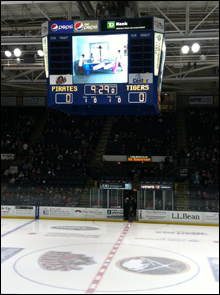
BRINGING ART TO THE MASSES Video projections at Portland Pirates games. |
Last Tuesday the crowd at the Portland Pirates game against Worcester sipped soda and munched on pretzels and popcorn as Canadian artist Graeme Patterson's two-minute video "Ten Point Game" was announced. Minutes before the game the Civic Center's JumboTron hovering over center ice cut from zippy promotional spots to the logo for the ICA. As the stop-animation began a few supportive shouts rang from the audience, and there was some confused whispering and the inevitable chitchat as people took their seats, but the crowd was largely attentive and curious.So began a series of three Pirates games that featured video screenings last week. Curated by the Institute of Contemporary Art's new director Daniel Fuller, the artworks, each related to hockey, served as ambassadors between Portland's art and sport communities. Stereotypically speaking, the ethnographic and over-analytical tendencies of the former camp might presumably look at the event as a concentrated sample of problematic prescribed social identities and narratives, while the latter might rather get the action started. The hockey theme of each of the films connected the two groups superficially, but provided an elemental common ground that quickly related the two, and displayed that the enjoyment of art and sport is not mutually exclusive.
The ICA's collaboration with the Portland Pirates stands as a curated situation, a confrontation and synthesis of two worlds that are largely considered to be culturally opposed. The contextualization of the art films in the sports arena aimed to gave rise to discussions of competition, commercialism, and audience, as well as, perhaps, to promote a rowdy and animated environment for the reception of art. Fuller is himself a sports fan, and views games as a gathering point, as a "shared, collective landscape with the joy of success and the agony of defeat." He imagined this cultural experiment to be a perfect opportunity to reach new audiences as a curator of art, and to engender important conversation.
In "Ten Point Game," the video screened on Tuesday, Canadian hockey hero Darryl Sittler unemotionally narrates his sequence of assists and goals that culminated in one of the greatest performances in NHL history on February 7, 1976. The 2008 interview with Sittler that serves as narration for the piece is dry and mechanical, seemingly diluted and dulled by the 30 years between the account and the event. Employing the framework of a vintage hockey table game, Patterson recreates the series of scores in accordance with Sittler's tale, leaning on the one-sidedness of the account and ultimately recasting the game as simple, unimpassioned, and somewhat ridiculous. Patterson's video engages with an alternate and multi-tiered world of play and memory as related to a moment steeped in collective nostalgia. He accesses the subjective angle of an experience shared and adored by many. He isolates the hero's tale, removing it from its spectacle status, and allows it to be told with the rigor of someone describing what they ate for breakfast.
"Ten Point Game" proved to be a surprising pause from an inundation of advertisements and promotional events, scantily clad skating ladies, and "Chuck the Puck." The collaboration cleverly engaged both communities, promoting new experiences for both and expanding the parameters of Portland's category of art venue while laying some stones between MECA and the Civic Center. While Fuller's intervention brought energy to art consumption and critical thinking to a sports event, it also got some recent attention from Tyler Green's Modern Art Notes, deemed "the most influential of all visual-art blogs" by the Wall Street Journal. We can't wait to see what Fuller's next move is.
Annie Larmon can be reached at aglarmon@gmail.com.